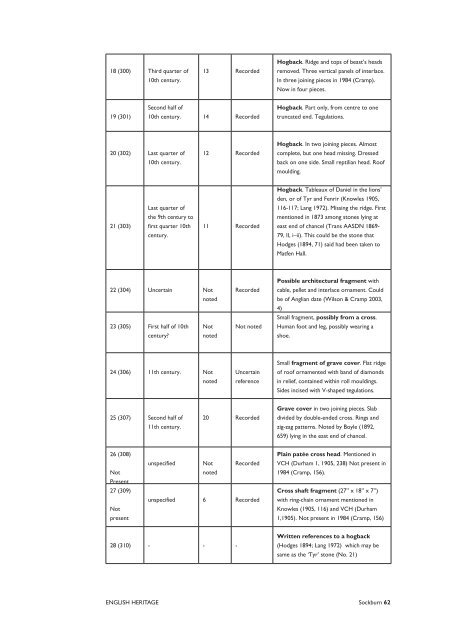Sockburn Hall, Darlington: an archaeological ... - English Heritage
Sockburn Hall, Darlington: an archaeological ... - English Heritage
Sockburn Hall, Darlington: an archaeological ... - English Heritage
Create successful ePaper yourself
Turn your PDF publications into a flip-book with our unique Google optimized e-Paper software.
18 (300) Third quarter of<br />
19 (301)<br />
10th century.<br />
Second half of<br />
20 (302) Last quarter of<br />
21 (303)<br />
13 Recorded<br />
10th century. 14 Recorded<br />
10th century.<br />
Last quarter of<br />
the 9th century to<br />
first quarter 10th<br />
century.<br />
22 (304) Uncertain Not<br />
23 (305) First half of 10th<br />
century?<br />
12 Recorded<br />
11 Recorded<br />
noted<br />
Not<br />
noted<br />
24 (306) 11th century. Not<br />
25 (307) Second half of<br />
26 (308)<br />
Not<br />
Present<br />
27 (309)<br />
Not<br />
present<br />
11th century.<br />
noted<br />
unspecified Not<br />
Recorded<br />
Not noted<br />
Uncertain<br />
reference<br />
20 Recorded<br />
noted<br />
Recorded<br />
unspecified 6 Recorded<br />
28 (310) - - -<br />
Hogback. Ridge <strong>an</strong>d tops of beast’s heads<br />
removed. Three vertical p<strong>an</strong>els of interlace.<br />
In three joining pieces in 1984 (Cramp).<br />
Now in four pieces.<br />
Hogback. Part only, from centre to one<br />
truncated end. Tegulations.<br />
Hogback. In two joining pieces. Almost<br />
complete, but one head missing. Dressed<br />
back on one side. Small reptili<strong>an</strong> head. Roof<br />
moulding.<br />
Hogback. Tableaux of D<strong>an</strong>iel in the lions’<br />
den, or of Tyr <strong>an</strong>d Fenrir (Knowles 1905,<br />
116-117; L<strong>an</strong>g 1972). Missing the ridge. First<br />
mentioned in 1873 among stones lying at<br />
east end of ch<strong>an</strong>cel (Tr<strong>an</strong>s AASDN 1869-<br />
79, II, i–ii). This could be the stone that<br />
Hodges (1894, 71) said had been taken to<br />
Matfen <strong>Hall</strong>.<br />
Possible architectural fragment with<br />
cable, pellet <strong>an</strong>d interlace ornament. Could<br />
be of Angli<strong>an</strong> date (Wilson & Cramp 2003,<br />
ENGLISH HERITAGE <strong>Sockburn</strong><br />
4)<br />
Small fragment, possibly from a cross.<br />
Hum<strong>an</strong> foot <strong>an</strong>d leg, possibly wearing a<br />
shoe.<br />
Small fragment of grave cover. Flat ridge<br />
of roof ornamented with b<strong>an</strong>d of diamonds<br />
in relief, contained within roll mouldings.<br />
Sides incised with V-shaped tegulations.<br />
Grave cover in two joining pieces. Slab<br />
divided by double-ended cross. Rings <strong>an</strong>d<br />
zig-zag patterns. Noted by Boyle (1892,<br />
659) lying in the east end of ch<strong>an</strong>cel.<br />
Plain patée cross head. Mentioned in<br />
VCH (Durham 1, 1905, 238) Not present in<br />
1984 (Cramp, 156).<br />
Cross shaft fragment (27” x 18” x 7”)<br />
with ring-chain ornament mentioned in<br />
Knowles (1905, 116) <strong>an</strong>d VCH (Durham<br />
1,1905). Not present in 1984 (Cramp, 156)<br />
Written references to a hogback<br />
(Hodges 1894; L<strong>an</strong>g 1972) which may be<br />
same as the ‘Tyr’ stone (No. 21)

















